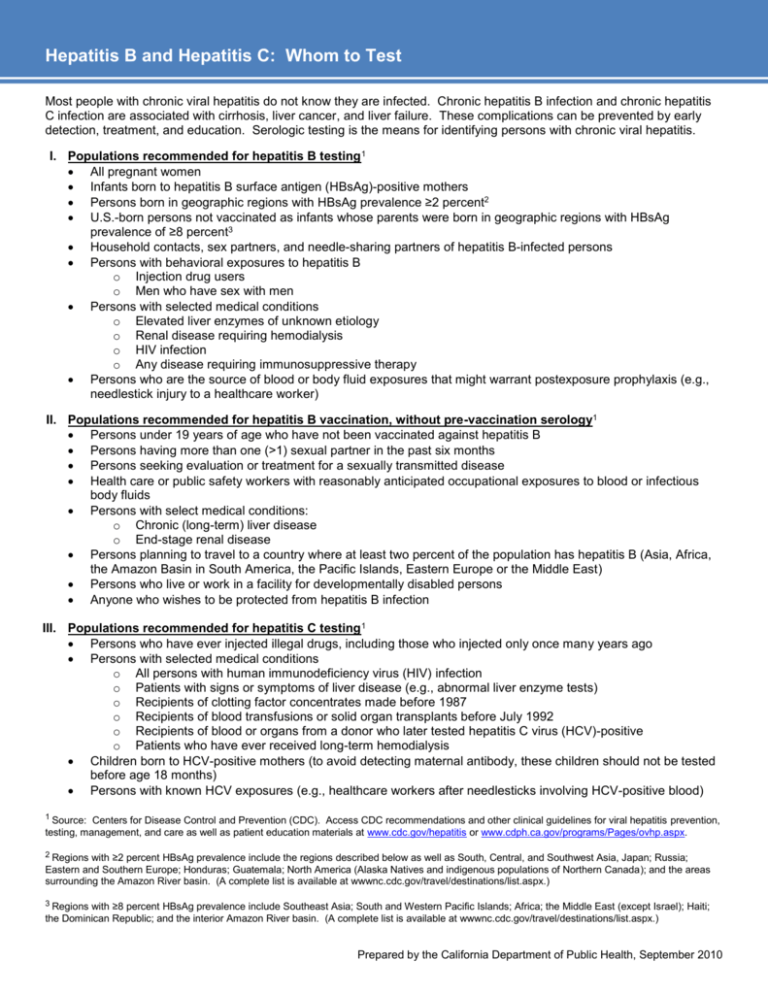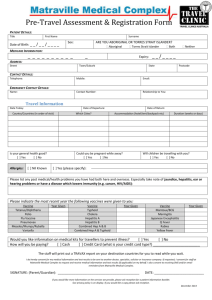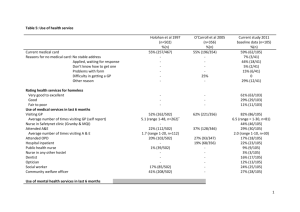
Hepatitis B and Hepatitis C: Whom to Test
Most people with chronic viral hepatitis do not know they are infected. Chronic hepatitis B infection and chronic hepatitis
C infection are associated with cirrhosis, liver cancer, and liver failure. These complications can be prevented by early
detection, treatment, and education. Serologic testing is the means for identifying persons with chronic viral hepatitis.
I. Populations recommended for hepatitis B testing 1
All pregnant women
Infants born to hepatitis B surface antigen (HBsAg)-positive mothers
Persons born in geographic regions with HBsAg prevalence ≥2 percent2
U.S.-born persons not vaccinated as infants whose parents were born in geographic regions with HBsAg
prevalence of ≥8 percent3
Household contacts, sex partners, and needle-sharing partners of hepatitis B-infected persons
Persons with behavioral exposures to hepatitis B
o Injection drug users
o Men who have sex with men
Persons with selected medical conditions
o Elevated liver enzymes of unknown etiology
o Renal disease requiring hemodialysis
o HIV infection
o Any disease requiring immunosuppressive therapy
Persons who are the source of blood or body fluid exposures that might warrant postexposure prophylaxis (e.g.,
needlestick injury to a healthcare worker)
II. Populations recommended for hepatitis B vaccination, without pre-vaccination serology1
Persons under 19 years of age who have not been vaccinated against hepatitis B
Persons having more than one (>1) sexual partner in the past six months
Persons seeking evaluation or treatment for a sexually transmitted disease
Health care or public safety workers with reasonably anticipated occupational exposures to blood or infectious
body fluids
Persons with select medical conditions:
o Chronic (long-term) liver disease
o End-stage renal disease
Persons planning to travel to a country where at least two percent of the population has hepatitis B (Asia, Africa,
the Amazon Basin in South America, the Pacific Islands, Eastern Europe or the Middle East)
Persons who live or work in a facility for developmentally disabled persons
Anyone who wishes to be protected from hepatitis B infection
III. Populations recommended for hepatitis C testing 1
Persons who have ever injected illegal drugs, including those who injected only once many years ago
Persons with selected medical conditions
o All persons with human immunodeficiency virus (HIV) infection
o Patients with signs or symptoms of liver disease (e.g., abnormal liver enzyme tests)
o Recipients of clotting factor concentrates made before 1987
o Recipients of blood transfusions or solid organ transplants before July 1992
o Recipients of blood or organs from a donor who later tested hepatitis C virus (HCV)-positive
o Patients who have ever received long-term hemodialysis
Children born to HCV-positive mothers (to avoid detecting maternal antibody, these children should not be tested
before age 18 months)
Persons with known HCV exposures (e.g., healthcare workers after needlesticks involving HCV-positive blood)
1 Source:
Centers for Disease Control and Prevention (CDC). Access CDC recommendations and other clinical guidelines for viral hepatitis prevention,
testing, management, and care as well as patient education materials at www.cdc.gov/hepatitis or www.cdph.ca.gov/programs/Pages/ovhp.aspx.
2 Regions
with ≥2 percent HBsAg prevalence include the regions described below as well as South, Central, and Southwest Asia, Japan; Russia;
Eastern and Southern Europe; Honduras; Guatemala; North America (Alaska Natives and indigenous populations of Northern Canada); and the areas
surrounding the Amazon River basin. (A complete list is available at wwwnc.cdc.gov/travel/destinations/list.aspx.)
3 Regions
with ≥8 percent HBsAg prevalence include Southeast Asia; South and Western Pacific Islands; Africa; the Middle East (except Israel); Haiti;
the Dominican Republic; and the interior Amazon River basin. (A complete list is available at wwwnc.cdc.gov/travel/destinations/list.aspx.)
Prepared by the California Department of Public Health, September 2010
Hepatitis B and C: Patient Self-Administered Risk Assessment
Hepatitis B and C are transmitted in different ways. Most people do not know they are infected until they are tested.
Hepatitis vaccination and testing are available at this clinic. Please check if these statements apply to you.
I. Have you been exposed to hepatitis B?
Were you born in an area of the world where at least two percent of the population has hepatitis B (Asia, Africa,
the Amazon Basin in South America, the Pacific Islands, Eastern Europe, or the Middle East)?
Were you not vaccinated for hepatitis B as infants?
Was your mother infected with hepatitis B when you were born?
Are you pregnant?
Are you HIV-positive, have an HCV infection, or on immunosuppressive therapy?
Did you have abnormal liver enzyme test results for an unknown reason?
Have you ever been on hemodialysis?
Have you had a sexual partner who was infected with hepatitis B?
Have you lived in the same house with someone infected with hepatitis B?
Are you a man who has sex with men?
Have you ever injected illicit drugs or shared drug injection equipment?
Have you shared needles with someone infected with hepatitis B?
Are you a health care or public safety worker with a known, recent occupational exposure to hepatitis B-infected
blood or bodily fluids (e.g., through an accidental needle stick)?
____
None of the above
____
Yes, at least one of the above applies to me
II. Do you need to be vaccinated against hepatitis B?
Are you under 18 but have not been vaccinated against hepatitis B?
Have you had more than one sexual partner in the past six months?
Are you seeking evaluation or treatment for a sexually transmitted disease?
Are you a health care or a public safety worker with reasonably anticipated occupational exposures to blood or
infectious body fluids?
Do you have chronic (long-term) liver disease?
Do you have end-stage renal disease?
Are you planning to travel to a country where at least two percent of the population has hepatitis B (Asia, Africa,
the Amazon Basin in South America, the Pacific Islands, Eastern Europe or the Middle East)?
Do you live or work in a facility for developmentally disabled persons?
Do you wish to be protected from hepatitis B infection?
____
None of the above
____
Yes, at least one of the above applies to me
III. Have you been exposed to hepatitis C?
Have you ever injected illicit drugs, even once, many years ago?
Did you receive donated blood or donated organs before 1992 and/or blood clotting products before 1987?
Have you ever been on hemodialysis?
Are you a health care or public safety worker with a known, recent occupational exposure to hepatitis C-infected
blood or bodily fluids (e.g., through an accidental needle stick)?
Are you HIV-positive?
Have you had signs or symptoms of liver disease (e.g., abnormal liver enzyme tests, jaundice)?
Was your mother infected with hepatitis C when you were born?
____
None of the above
____
Yes, at least one of the above applies to me
_________________________________________________________________________________________________________________________
For administrative use only:
If yes to I, order test for HBV (HBsAg and anti-HBs)
If yes to II, administer first dose of HBV vaccine
If yes to III, order test for HCV (anti-HCV)
□
□
□: Testing and
Serolo
Prepared by the California Department of Public Health, September 2010
Hepatitis B: Testing and Serology
Hepatitis B is an infection caused by the hepatitis B virus (HBV). Chronic infection with HBV is associated with cirrhosis, liver
cancer, and liver failure. These complications can be prevented by treatment and patient education (e.g., regarding alcohol
use and liver self-care). Serologic testing is the primary means for identifying persons with chronic HBV infection. An
effective vaccine is available to prevent HBV infection.
Serologic Markers*
HBsAg:
Hepatitis B surface
antigen
Anti-HBs:
Antibody to HBsAg
* Note: Another HBV test is total antibody to hepatitis B core antigen (anti-HBc), which can be used to distinguish whether
immunity is due to past infection (anti-HBc-positive) or to previous vaccination (anti-HBc-negative). In patients with chronic
HBV infection, anti-HBc is also present. In the absence of HBsAg or Anti-HBs, an anti-HBc-positive test result has one of
four interpretations: 1) recovering from acute HBV infection; 2) distantly immune, test not sensitive enough to detect very
low level of anti-HBs in serum; 3) susceptible with a false positive anti-HBc; or 4) chronically infected with an undetectable
level of HBsAg in serum.
Hepatitis B Vaccination
3 doses are administered at 0, 1, 6 months; a combination hepatitis A/hepatitis B vaccine is available and follows the
same dosing schedule
If partially vaccinated, the patient does not need to restart the series
Vaccine is safe for pregnant and HIV-infected persons
Post-vaccine serology testing (anti-HBs) is recommended for household, needle-sharing, and sexual contacts of HBsAgpositive persons, HIV-positive persons, and healthcare workers
Booster doses may be indicated for hemodialysis patients, HIV-infected persons, and other immunocompromised
persons
Principles of Long-Term Hepatitis B Management
Provide patient with culturally and linguistically appropriate educational materials (see links below)
Report case to local health department within seven days
Vaccinate against hepatitis A unless immune
Encourage patient’s sex partners, household members, and injection-drug sharing contacts to seek HBV testing, medical
evaluation, and vaccination
Counsel patient to minimize alcohol consumption and other liver toxins
Counsel patient to avoid sharing razors, toothbrushes or personal injection equipment
Seek a hepatitis B-experienced clinician to evaluate for, manage, and treat chronic HBV infection
Access clinical guidelines for HBV prevention, testing, management, and care as well as patient education materials at
www.cdc.gov/hepatitis or www.cdph.ca.gov/programs/Pages/ovhp.aspx.
Prepared by the California Department of Public Health, September 2010
Hepatitis B: Billing and Diagnosis Codes
CPT Codes
ICD-9 Diagnosis Codes
90632
Monovalent hepatitis A vaccine for adult
dosage
V01.7
90633
Monovalent hepatitis A vaccine for
pediatric/adolescent use (2-dose schedule)
V05.3
90634
90743
90745
90636
90740
90747
042
V08
Vaccine Codes
90746
Monovalent hepatitis A vaccine for
pediatric/adolescent use (3-dose schedule)
Monovalent hepatitis B vaccine for adult
dosage
Monovalent hepatitis B vaccine for adolescent
use (2-dose schedule)
Monovalent hepatitis B vaccine for pediatric
use (3-dose schedule)
Combination hepatitis A/hepatitis B vaccine
for adult dosage
Hepatitis B vaccine for dialysis or
immunosuppressed patient
(3-dose schedule)
Hepatitis B vaccine for dialysis or
immunosuppressed patient
(for 40 mcg dosing and 4-dose schedule)
V69.2
571.8
571.9
070.3
36415
87515
Infectious agent detection by nucleic acid
(DNA or RNA); hepatitis B virus, direct probe
technique
36410
87341
Infectious agent detection by nucleic acid
(DNA or RNA); hepatitis B virus, amplified
probe technique
Infectious agent detection by nucleic acid
(DNA or RNA); hepatitis B virus, quantification
Infectious agent antigen detection by enzyme
immunoassay technique, qualitative or
semiquantitative, multiple-step method;
hepatitis B surface antigen (HBsAg)
Infectious agent antigen detection by enzyme
immunoassay technique, qualitative or
semiquantitative, multiple-step method;
hepatitis B surface antigen (HBsAg),
neutralization
90472
Each additional vaccine (single or
combination vaccine); (list separately in
addition to the code for primary procedure)
Administration Codes
90741
Immunization administration (includes
percutaneous, intra-dermal, subcutaneous,
intramuscular and jet injections, one vaccine
(single or combination vaccine/toxoid)
Office or outpatient visit for the evaluation
or management of a new patient
Venipuncture, cutdown; age 1 or over
Collection of venous blood by
venipuncture
Venipuncture, age 3 years or older,
necessitating physician's skill (separate
procedure), for diagnostic or therapeutic
purposes (not to be used for routine
venipuncture)
Testing Codes
87340
Chronic hepatitis B without mention of hepatic
coma
E & M Codes
9020199205
36425
Hepatitis B surface antibody (HBsAb)
87517
Other chronic nonalcoholic liver disease
Unspecified chronic liver disease without the
mention of alcohol
CPT Codes
86706
87516
Contact with or exposure to communicable
diseases, other viral diseases
Need for prophylactic vaccination and
inoculation against single disease: viral
hepatitis
Human immunodeficiency virus (HIV) disease
Asymptomatic human immunodeficiency virus
(HIV) infection status
High-risk sexual behavior
CPT copyright 2008 American Medical Association. All rights reserved.
Prepared by the California Department of Public Health, September 2010
Hepatitis C: Testing and Serology
Hepatitis C is an infection caused by the Hepatitis C virus (HCV). Chronic infection with HCV is associated with
liver failure, cirrhosis, and liver cancer. Serologic testing is the primary way to identify persons with chronic HCV
infection. These complications can be prevented by treatment and patient education (i.e., regarding alcohol use
and liver self-care). Currently, no vaccine is available to prevent HCV infection.
Serologic Markers
Anti-HCV:
Hepatitis C surface
antibody is used to
detect the presence of
antibodies to the virus,
indicating exposure to
HCV
HCV RNA:
Test used to detect the
presence (qualitative) or
amount (quantitative) of
virus and distinguish
between a current or
past infection
RIBA:
Recombinant
immunoblot assay used
as an additional and
more specific test to
confirm the presence of
HCV antibodies and rule
out false positives
* Note: 95 percent of samples with a high signal-to-cutoff (s/co) ratio will be predictive of a true antibody positive result,
regardless of the anti-HCV prevalence or characteristics of the population being tested. A list of the s/cos (or threshold
values) that are predictive of a true positive for available commercial assays can be retrieved at
www.cdc.gov/hepatitis/HCV/LabTesting.htm . If a false positive test result is suspected, supplemental HCV antibody
and/or HCV RNA testing should be conducted.
** Note: A single HCV RNA test result cannot determine chronic HCV infection status, as persons may have intermittent
viremia. Two positive HCV RNA tests six months apart are needed to diagnose a case of chronic HCV infection.
*** Note: Patients with recent (< 6 months) exposure who test anti-HCV-negative may not have yet developed detectable
antibodies. HIV-infected persons may not develop hepatitis C antibodies. HCV RNA testing should be considered for
immunocompromised persons.
Principles of Long-Term Chronic HCV Evaluation and Management
Provide patient with culturally and linguistically appropriate educational materials (see links below)
Report case to local health department within seven days
Vaccinate patients against hepatitis A and B unless immune
Advise patients to reduce or eliminate intake of alcohol and other liver toxins
Counsel patients to practice safer injection, follow infection control guidelines in healthcare and in settings such
as tattoo parlors, and avoid sharing personal items that might have blood on them, such as razors
Counsel patients to practice safer sex when engaging with multiple sex partners or infected with HIV
Seek a hepatitis C-experienced clinician to evaluate for, manage, and treat chronic HCV infection, either by
referral or through clinical consultation
Access clinical guidelines for HCV prevention, testing, management, and care as well as patient education
materials at www.cdc.gov/hepatitis or www.cdph.ca.gov/programs/Pages/ovhp.aspx
Prepared by the California Department of Public Health, September 2010
Hepatitis C: Billing and Diagnosis Codes
CPT Codes
86803
Hepatitis C antibody
86804
Hepatitis C antibody; confirmatory test
(e.g., immunoblot or RIBA)
Infectious agent detection by nucleic
acid (DNA or RNA); hepatitis C, direct
probe technique
Testing Codes
87520
ICD-9 Diagnosis Codes
V01.7
Contact with or exposure to communicable
diseases, other viral diseases
V05.3
Need for prophylactic vaccination and
inoculation against single disease: viral
hepatitis
042
Human immunodeficiency virus (HIV) disease
V08
Asymptomatic HIV infection status
V69.2
High-risk sexual behavior
571.8
Other chronic nonalcoholic liver disease
Infectious agent detection by nucleic
acid (DNA or RNA); hepatitis C,
amplified probe technique
87522
Infectious agent detection by nucleic
acid (DNA or RNA); hepatitis C,
quantification
9020199205
Office or outpatient visit for the
evaluation or management
of a new patient
571.9
Unspecified chronic liver disease without the
mention of alcohol
36425
Venipuncture, cutdown; age 1 or over
070.51
Acute hepatitis c without hepatic coma
36415
Collection of venous blood by
venipuncture
070.54
Chronic hepatitis C without hepatic coma
070.7
Unspecified viral hepatitis C
36410
Venipuncture, age 3 years or older,
necessitating physician's skill
(separate procedure), for diagnostic or
therapeutic purposes (not to be used
for routine venipuncture)
070.70
Unspecified viral hepatitis C without hepatic
coma
E & M Codes
87521
CPT copyright 2008 American Medical Association. All rights reserved.
Prepared by the California Department of Public Health, September 2010







